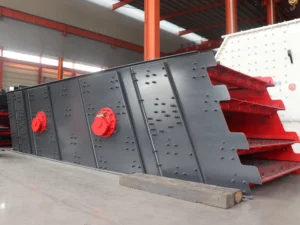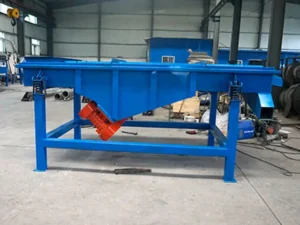Introduction:
Industries often use different advanced processes to differentiate one material from another. Screening is a process that lets you separate the materials based on their properties. The Circular vibrating screen or linear are the processes that you must have heard about. Whichever screening type you choose, different screening machines work with unique structures and trajectory motions to separate the materials. Learn the differences between the two screening types through this blog.
What is the circular vibrating screen?

How does it work if it is your first time seeing such a machine? It includes a motor, a belt, a vibrator, and a screening box. When you start operating the machine, the belt drives the motor. Then, this rotating action induces the centrifugal force that triggers the vibrating screen. It produces a revolving motion with a specific amplitude. Thus, once the circular vibrating screen starts vibrating, the material you want to separate stays on the sieve. At the same time, the unwanted materials filter out from the sieve. You can set the sieve holes according to the material size you want to filter out.
This machine allows you to sieve the residual material and send it to another processing unit. You could vary the vibration amplitude and screen rotation to achieve the output. Usually, people use such a machine type when they have many materials. With this, every particle undergoes the screening action as the rotation action allows this to happen. You can further choose the different mesh sizes for the sieve according to the specifications of the output material.
Mostly, the machine is applicable for coal and mining processing.
What is the linear vibrating screen?

Linear vibrating machines could have a single, double, or triple-deck system. In this screening type, you project the subjected material to a screen. Remember that the screen moves in a straight motion. The material then falls from a hopper feeder with a uniform action. Also, the machine includes two motors. With the action of the two motors, the subjected material falls on the machine’s surface with a linear motion. Moreover, the subjected material includes mixed materials of different sizes. These materials filter out at their specific outlet. Thus, you can easily separate them.
With this machine you can insert the sieves at different levels to achieve material of variable sizes. Thus, in a single machine, you could have up to size different sizes for the sieve. This machine with linear motion could help you in classifying the different materials.
The structure of these machines is quite simple and convenient to assemble and use. One more reason to use this type of screening machine is the high-quality output it delivers to you. Many industries like the food, chemical, and pharmaceutical industries rely on this screening machine.
Now, let’s move to the primary differences between a circular and a linear vibrating screen.
The differences between linear and circular vibrating screening
Below, you can see what makes the two screenings different.
-
Trajectory motion
A linear screen allows the material to move in a linear motion. Thus, with different sieving, extraction of required material is easier.
A circular vibrating screen suggests that such screening consists of revolving screening. Therefore, the subjected material undergoes a circular motion, and the material you want to extract can easily be extracted.
-
Exciters for vibration
The purpose of the exciters is to produce vibration for the screening process. You would see a double shaft type exciter in the linear screening machines. Moreover, it operates using an excitation motor.
The exciter installed in the circular screening machines is called a single-shaft exciter. Similarly, it works along an inertia motor.
-
Installation inclination
The inclination angle in the linear vibrating screen has a small height. Therefore, the material you want to project on the screen could easily fall on the screen surface. However, for the circular machine, the inclination includes an acute angle. Thus, compared to linear motion, it allows much more efficient results. The movement of the targeted material eventually varies with change in the inclination.
-
Structure of the screening machines
The manufacturers of linear screening machines designed them to produce less waste for the environment. It is possible because of the enclosed shape of the machine. Considering a circular screening machine, you can locate its exciter above the center of gravity. Thus, it produces the dispersion of material instantly. Similarly, this machine’s productivity and output capacity are always higher than the linear type screening machines.
-
Type of material
Manufacturers usually use stainless steel to design linear screening machines’ plates. In comparison, you will find the body of a circular screening machine different. Such a type of screening machine has a body of manganese steel. That’s because it works for heavy material separation, unlike linear machines. This material in which it gets designed prevents its body from getting directly exposed to the hard projected material.
-
Applications
A linear vibrating screen could work for you if you require small, fine, soft, powered, or micro-powered type output. Usually, food and chemical industries make use of such screening types.
Use a circular vibrating machine if you require a large and rigid material in the output. Thus, it is more effective for materials that aren’t easily screened. Coal plants and mines make use of such screening.
-
Output capacity
The linear vibrating screen machine could produce more refined output than a circular screen. That’s because it is capable of working on small and soft materials. However, when you consider a circular vibrating machine, it produces greater capacity. The reason behind this is the spindle that offers a spinning motion in the machine. For example, the spindle works in an anticlockwise direction, then the movement of material occurs in its opposite direction. Thus, it then produces a highly efficient screening output capacity.
Conclusion:
Circular vibrating screen and the linear come with different properties, input and output features. These both have different principle of working and, similarly, delivers a distinctive output. It is up to you which kind of machine suits you, you can opt for it.
